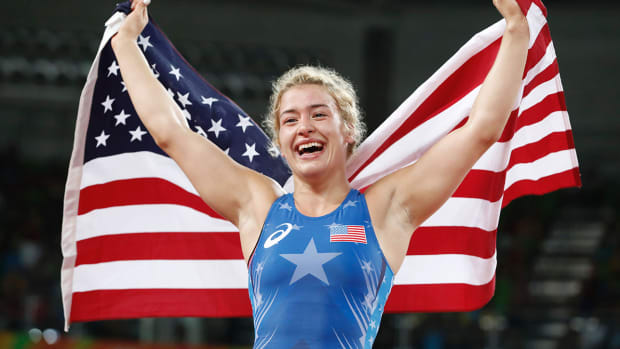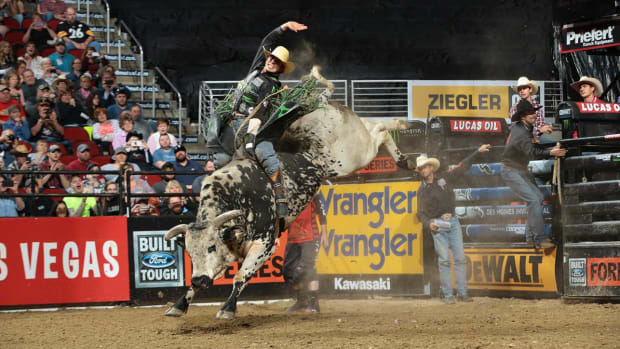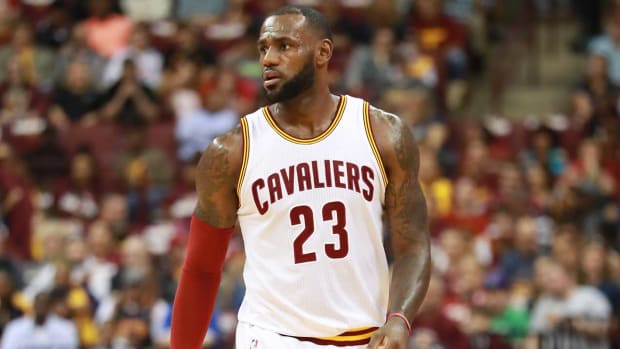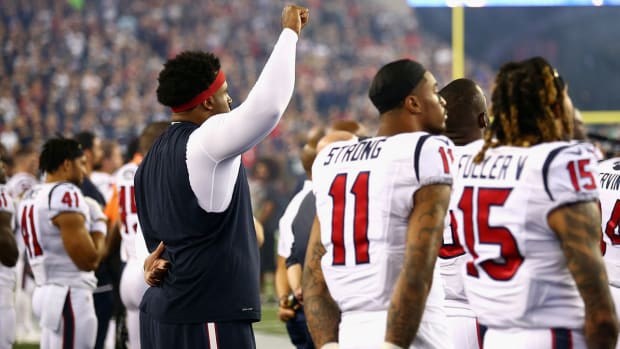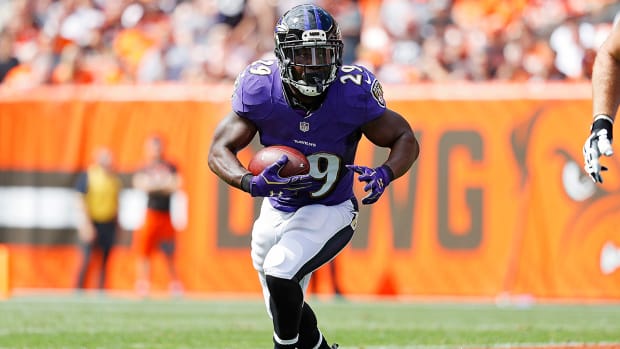Quarterback play is keeping the SEC from reclaiming its spot atop football
After nearly a decade of dishing out swirlies to the Big 12, giving wedgies to the Pac-12, and stuffing the Big Ten in every available locker, the big bad bully of college football, the SEC, doesn’t look so tough. Just a few weeks into the 2015 college football season, we’ve already seen then-No. 16 Arkansas lose at home to Toledo and follow it up with a loss to Texas Tech. Playoff hopeful Auburn nearly lost to FCS Jacksonville State before being obliterated by conference foe LSU. Meanwhile, 2014 SEC East champion Missouri was but one fake field goal away from losing to UConn ... at home. Worse still for the self-described kings of college football, the last two seasons have ended with a coach outside the SEC receiving the ceremonial Gatorade bath.
So what's changed to make the SEC seem so mortal? Only the single-most important position on the field, one whose changing dynamic has found this once-unstoppable guild mired in an awkward game of catch-up.
For years, the SEC blueprint wasn't all that different from the Big Ten's. The first objective: a punishing ground game. By 2006, the SEC had become roughly a thousand times better at it than the their Northern rivals. Alabama had Mark Ingram, Trent Richardson, Eddie Lacey, and T.J. Yeldon. Auburn boasted Cam Newton and Michael Dyer. Tim Tebow and Percy Harvin (who ran the ball in addition to playing wide receiver) helped define Florida's thunder-and-lighting persona, while LSU fielded an effective tandem of Jacob Hester and Trindon Holliday.
• MORE: Ole Miss is top SEC team in Power Rankings, at No. 5
The second objective: deploy a nightmarish front seven that made scheming against them as enjoyable as a Hoobastank concert. Players like Carlos Dunlap, Marcell Dareus, Glenn Dorsey, Nick Fairley, and others made a living abusing their collegiate foes before moving on to Sunday paychecks. From 2006, the year Florida shocked the college football world by running an undefeated Ohio State team off the field through Florida State's narrow victory over Auburn in the 2014 national title game, the SEC had 27 NFL first-round draft picks just at the defensive line and linebacker positions.
Other conferences were producing excellent running backs during this period, of course, but nobody came close to matching the SEC’s talent output on the defensive side of the ball—particularly along the front seven. And thanks to the South's fertile recruiting grounds, the SEC should continue to collect the best prospects at those positions. In fact, the crown jewel of the SEC, Alabama, has finished with the top-ranked class in each of the last four recruiting cycles, according to ESPN’s rankings. What's more, the SEC has never finished with fewer than eight teams ranked in the top 25 for recruiting.
What has changed during the SEC’s dynastic run, however, is the potency and ever-changing complexity of college football offenses. Nick Saban can place all the blame he wants on rule changes, spread attacks, tempo, or the NFL's evaluation period; football is a now an offense-centric sport, and the imperative is now an old adage: evolve or perish.
When Urban Meyer and Florida won the 2006 national title, six of the top 10 teams in the final AP Poll also finished in the top 10 in scoring defense nationally: Florida, Ohio State, LSU, Wisconsin, Michigan and Auburn, each of which gave up fewer than 15 points per contest.
Fast forward to 2015, and the defensive ranking for teams in the AP's final top 10 were markedly different. In fact, College Football Playoff participant Alabama was the only team to finish in the top 10 in both the AP poll and points allowed.
The other top-10 teams at the end of last season finished no higher than 12th in overall defense (Michigan State), and as low as 74th (UCLA). National champion Ohio State ended the year ranked 23rd in points allowed (21.2 per game). When last year’s stingiest defense, Ole Miss (13.8 ppg), went up against TCU in the Peach Bowl, the Rebels were trounced 42–3.
In 2006, up-tempo spread offenses still were viewed as a kind of fringe science. Back then, the only four teams to eclipse 6,000 yards of offense were Hawaii, Houston, BYU, and Louisville (a member of the Big East at the time). After a slight dip in across-the-board offensive production in 2009, the "air raid offense"—the spread, zone read, read option, and others of their ilk—began to dominate the grease board, thanks in no small part to creative alchemists like Oregon's Chip Kelly. Even teams prone to traditional, pro-style offenses began incorporating more dynamic, shape-shifting features. The result was a brave new world of college football in which it was becoming increasingly crucial for teams to be physical at the point of attack and be able to stretch opposing defenses vertically.
This changing landscape, and the increased emphasis on the quarterback position, was perhaps best illustrated during last year's inaugural College Football Playoff. The first matchup, between Oregon and Florida State, pitted the two most recent Heisman trophy winners—Jameis Winston and Marcus Mariota—on their way to becoming the No. 1 and No. 2 picks, respectively, in the 2015 NFL Draft.
The second game, meanwhile, featured arguably the nation's two most complete teams: Alabama and Ohio State, whose rosters were littered with NFL talent. The Tide boasted a certifiably bananas talent pool, with T.J. Yeldon, Amari Cooper and Derrick Henry on offense and Landon Collins, Jonathan Allen, Reggie Ragland and A’Shawn Robinson on the other side. Ohio State countered with Ezekiel Elliott, Michael Thomas, Devin Smith, Joey Bosa, Darron Lee, and Von Bell.
• MORE: Clemson co-OCs reflect on experiences that shaped them
The one glaring difference between the two, however, was the level of talent at quarterback. Once the game turned into a shootout, Ohio State was able to keep Alabama's running attack largely in check, thereby putting the pressure on senior quarterback Blake Sims. Sims would go on to commit three costly turnovers: one that resulted in a pick-six, a second that occurred with the Tide deep in Buckeye territory, and a third that sealed the game. In fact, it took Sims until late in the fourth quarter to complete his first pass deep downfield.
Then you had Ohio State. Led by Cardale Jones, the Buckeyes were able to effectively stretch Alabama’s defense to its breaking point, yielding multiple explosive plays—including a 42-yard touchdown strike to Devin Smith and a game-clinching 85-yard run by Elliott.
Sims, along with a number of graduating SEC quarterbacks, went undrafted. Meanwhile, and despite some early struggles this season, Cardale Jones is safely projected as a first-round pick in the 2016 NFL draft owing to a unique combination of size, deceptive speed, and a trebuchet of an arm. If Jones continues this trajectory, he will likely be the third first-round pick from the inaugural Playoff.
While this could be a one-season aberration, all signs from early in the 2015 season point to this trend continuing. The current top two teams, Ohio State and Michigan State, both boast first-round-caliber quarterbacks, while other upper-echelon teams—Clemson and UCLA, in particular—already have NFL scouts drooling over the 2017 and '18 drafts. For a majority of the SEC teams expected to compete for the conference title, however, the quarterback situation is far more tenuous — and in some cases outright unstable.
Alabama suffered its first loss of the season—a narrow 43-37 home defeat at the hands of Ole Miss two weeks ago—thanks in part to Jake Coker and Cooper Bateman being unable to perform at the position. Meanwhile, over at Auburn, Jeremy Johnson’s Heisman campaign has gone about as well as Scott Walker’s presidential run.
Despite an excellent start, graduate transfer Greyson Lambert still has Georgia fans hopping aboard the hype train with caution, unsure if his 76.5% completion rate and 7-to-0 touchdown-to-interception ratio merely are football fool's gold. That's understandable, given Lambert's pedestrian numbers over a 5-7 campaign as the starting slinger for Virginia a season ago (10 touchdowns and 11 interceptions, along with a sub-60 completion percentage).
Heisman Watch: LSU's Leonard Fournette holds onto top spot
Then there's LSU, also enjoying a strong start after besting both Mississippi State and Auburn. However, the Tigers owe must of their success to sophomore running back Leonard Fournette, whose absurd, cheat-code-worthy feats have put him at the front of the Heisman Trophy race. Through three games, Harris has attempted only 47 passes and registered just 302 passing yards and two touchdowns. Or, in other words, a bad half for TCU.
Finally, down in Oxford, Ole Miss coach Hugh Freeze has finally answered the question, “What would it have been like if Vanilla Ice was a D-I athlete?” by handing the starting spot to noted Twitter troll and Kalashnikov enthusiast Chad Kelly. After helping his team beat Alabama (in Tuscaloosa, no less), Kelly certainly deserves some of the credit. Still, questions abound over whether a quarterback once benched during a spring game can keep his act together for an entire season.
At this point, only one team—Texas A&M—can safely be said to boast a true pro prospect at quarterback. Indeed, sophomore Kyle Allen has both the pedigree and the tools to someday grace the first-round podium. Coupled with the enormous sum of money A&M used to lure LSU defensive coordinator John Chavis to College Station, Kevin Sumlin’s Aggies could surprise people, with a chance to emerge as SEC champs for the first time since joining the conference.
The SEC isn’t going away, and nor is it trending towards a Big Ten-esque Dark Age; its sheer regional talent, together with the almost religious support placed on the sport, simply won't allow it. At the same time, the blueprint that long defined the SEC's college football dominance is in need of an adjustment—if not an outright redesign.
Given recent trends, great offense is likely to continue trumping great defense. Add to that the demands of being crowned champions in today's NCAA—a clean season slate, a conference title, and a pair of playoff wins— and more consistent quarterback play stands to be the single biggest X-factor in the SEC's attempt to reclaim its national throne.





